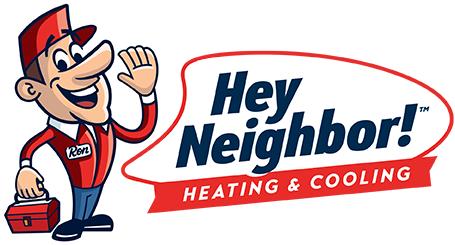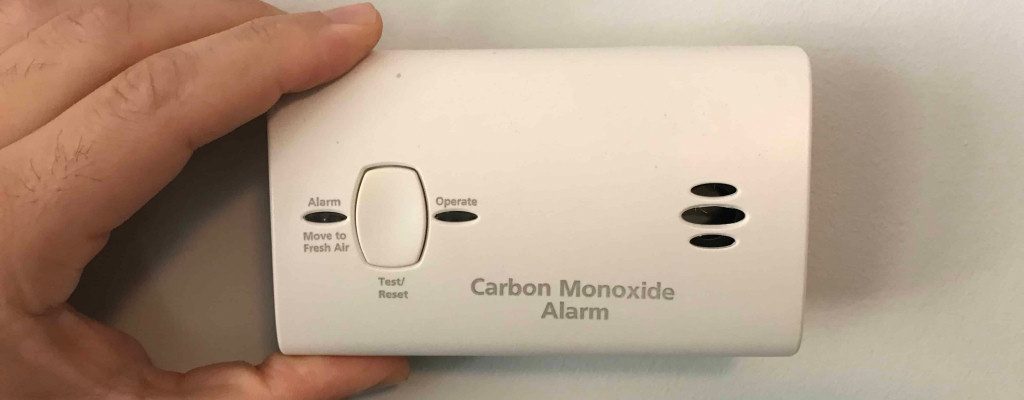We often hear from our customers who want to minimize the risk of carbon monoxide (CO) poisoning. At Hey Neighbor Heating & Cooling, we’re happy to share information about protecting your indoor air quality (IAQ), especially regarding this silent killer’s deadly nature.
What is CO gas?
Carbon monoxide is an odorless, colorless gas that is virtually impossible to detect without specialized equipment. Like the air we breathe, it’s invisible and produces no scent. Inhaling it can cause health problems and even death.
Each year, CO poisoning is responsible for more than 20,000 emergency room visits, 4,000+ hospitalizations, and over 400 deaths in the United States, according to the Centers for Disease Control. So to promote safety and well-being for our neighbors, here’s what you need to know about this harmful airborne pollutant.
How is CO produced?
Various substances create CO gases via combustion. Flammable materials like wood, gas, oil, coal, and propane contain carbon. CO molecules are produced due to carbon that has only partially burned.
What are the risks?
CO poisoning is a potentially severe health hazard. It’s toxic to the human body and can be fatal. When it’s inhaled into the lungs, the bloodstream absorbs it. From there, it starts to displace oxygen, which is essential for the brain, heart, and other vital organs to function.
The severity of harm depends on how much CO you inhale and the length of time you’re exposed to the gas. Small amounts may produce mild effects, whereas high concentrations can cause vomiting or fainting.
Leaks in homes tend to go unnoticed. Victims may develop a headache, feel dizzy, or have an upset stomach. As a result, CO poisoning may be mistaken for illness. That said, a CO leak in your home can be much larger in scale. This can quickly cause severe symptoms and lead to death.
What are the symptoms of CO poisoning?
As a general rule, the more severe a person’s symptoms are, the greater the exposure. However, vulnerable groups like the elderly or young children may be more sensitive to lower concentrations of CO.
Mild symptoms include:
• Nausea
• Headache
• Weakness
• Dizziness
• Chest pain
Severe symptoms include:
• Difficulty breathing
• Vomiting
• Confusion
• Blurred vision
• Loss of consciousness
In addition to greater sensitivity, vulnerable groups are at higher risk of death due to exposure. Additionally, being asleep or intoxicated increases the risk, since it is difficult or impossible for a person to notice symptoms.
How much CO is too much?
Let’s be clear about CO – inhaling any amount of it is terrible for you. However, healthy adults generally don’t display symptoms at concentrations below 70ppm (parts per million), according to the Consumer Product Safety Commission. Even so, vulnerable people may experience health issues at this stage. The danger zone is above 70 ppm, and at levels above 150 ppm, those exposed may suffer confusion, fainting, muscle failure, and even death.
How can I protect my home against this threat?
Remain vigilant and keep your living space safe from CO for yourself, your family, and your pets. You can save lives by staying mindful of the simple things we describe below.
The most effective way to protect your family from an unnoticed leak is to install CO alarms in your home. These life-saving devices are inexpensive and can be found at most hardware and department stores. A good guideline is to place one on each floor – preferably in each bedroom. Also, like your smoke detectors, remember to change their batteries annually and test them monthly!
It’s wise to read through the instruction manuals for your fuel-burning appliances. This includes stoves, water heaters, fireplaces, and of course, your furnace. When you need a repair, always let the pros take care of it. For risk reduction and other reasons, it’s wise to have seasonal maintenance performed each year. Maintenance visits allow our professional team to discover and eliminate any CO risk factors.
We can’t stress this strongly enough: Never operate fueled appliances in spaces that aren’t well-ventilated. Doing so is sure to create massive amounts of CO.
Likewise, never leave your gas stovetop running when you’re not using it, and double-check the burners are turned off when you’re done cooking. Also, never, ever use your oven to heat your home.
Finally, don’t leave your car idling in the garage. Even with the garage door open, doing this has significant potential for CO inhalation.
Concerned about CO in your home?
Our helpful Hey Neighbor Heating & Cooling team hopes you found these tips educational. Our goal is always to help all of our neighbors in Northeast Ohio stay safe and healthy. If you need emergency service on your home’s HVAC system or have concerns about CO, please call us at 844-HEY-NEIGHBOR or conveniently request service online today. Your family’s comfort and safety are our goals!


Comments are closed